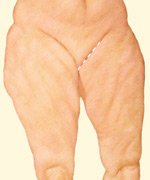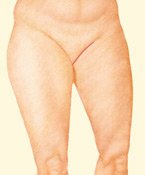If fitness and weight loss efforts have not achieved your goals for a body that is firmer, more youthful-looking, and more proportionate to your overall body image, a surgical thigh lift may be right for you. A thigh lift reshapes the thighs by reducing excess skin, and in some cases fat, resulting in smoother skin and better-proportioned contours of the thighs and lower body.
Is a thigh lift right for me?
Candidates for Boston thigh lift surgery have:
- Body weight that has been stable for at least 6 months
- Excess tissue along the inner (medial) thigh and/or the outer thigh
- No medical conditions that can impair healing or increase the risk of surgery
- A positive outlook and realistic goals for thigh lift surgery
- Commitment to a healthy lifestyle with good nutrition and fitness
What it won’t do: Thigh lifts are not intended strictly for the removal of excess fat. Liposuction alone can remove excess fat deposits where the skin has good elasticity and is able to naturally conform to new body contours. In cases where skin elasticity is poor, a combination of liposuction and thigh lift techniques may be recommended.
Anesthesia
General anesthesia medications are administered for your comfort during the surgical procedure. This means that you will be completely asleep throughout the procedure.
The incision
Incision patterns vary based on the area or areas to be treated, degree of correction, and patient and surgeon preference.
One common technique used for a thigh lift involves curvilinear incisions, extending from the medial knee (inner knee) to the anterior (front) groin crease. The underlying tissue matrix will be reshaped and tightened, and skin will be reduced and redraped resulting in more proportionate and smoother body contours.
Certain patients may qualify for a minimal incision medial thigh lift (or “short scar” technique), which involves an incision only in the groin area. Your surgeon will determine what’s appropriate. In most cases, especially after significant weight loss, improving the contours of the outer thigh requires a lengthier incision.
Through these incisions, your plastic surgeon will tighten tissues for a smoother, better-toned lower body contour. Advanced techniques usually allow incisions to be placed in strategic locations where they can be hidden by most types of clothing and swimsuits. However, incisions may be extensive. Deep support sutures within underlying tissues help to form the newly shaped contours. Sutures close the skin incisions.
Before and After: Medial Thigh Lift (Illustration)
Results of thigh lift surgery
The smoother, tighter contours that result from a thigh lift are apparent almost immediately, although initially obscured by some swelling and bruising. You will likely be required to wear a compression garment for several weeks following your procedure to minimize swelling and support the tissues as they heal.
Following a thigh lift, skin quality is dramatically improved both in appearance and feel.
The decision to have thigh lift surgery is extremely personal and you’ll have to decide if the benefits will achieve your goals and if the risks and potential complications are acceptable.
Your plastic surgeon and/or their staff will explain in detail the risks associated with surgery. You will be asked to sign consent forms to ensure that you fully understand the procedure you will undergo and any risks and potential complications.
- Key Benefits
- Glossary
- Enhances thigh shape and contour
- Smoothes skin by eliminating sagging
- Reduces chafing and discomfort
- Allows for a better fit in clothing, especially in tighter outfits
Thigh Lift: A surgical procedure designed to remove excess skin and fat from the thighs, resulting in smoother, firmer thighs.
Thigh Lift Surgery: The surgical process of removing excess skin and fat from the inner or outer thighs to enhance their appearance.
Plastic Surgeon: A medical professional specialized in performing plastic and reconstructive surgeries, including thigh lifts, to improve the body’s appearance and function.
Plastic Surgery: A branch of surgery focused on reconstructing, altering, or enhancing the human body, including procedures like thigh lifts, liposuction, and other cosmetic surgeries.
Excess Skin: The additional skin that remains after significant weight loss or aging, which can be removed through a thigh lift surgery.
Excess Fat: Unwanted fat deposits in the thigh area that can be removed during a thigh lift procedure to improve the contour of the thighs.
Liposuction: A cosmetic surgery technique used to remove excess fat from specific areas of the body, often used in conjunction with thigh lift surgery.
Incision: A surgical cut made in the skin during the thigh lift procedure to remove excess skin and fat.
Inner Thigh: The medial, inner part of the thigh, which is often a target area for thigh lift procedures to remove sagging skin and improve leg contours.
Outer Thighs: The outer part of the thighs, which can also be treated in a thigh lift procedure to enhance the overall appearance of the legs.
Groin Area: The area where the inner thighs meet the lower abdomen, often involved in thigh lift procedures for better access to thigh tissues.
Thighplasty: Another term for thigh lift surgery, focusing on removing excess skin and fat from the thighs.
Posterior Lift: A surgical procedure that targets the back of the thighs and buttocks, often performed alongside a thigh lift for comprehensive body contouring.
Ideal Candidate: A person who is in good health, has realistic expectations, and is looking to remove excess skin and fat from their thighs, making them suitable for a thigh lift.
General Anesthesia: A type of anesthesia used during thigh lift surgery to ensure the patient is unconscious and pain-free during the procedure.
Recovery Process: The period after thigh lift surgery during which the patient heals, and the results of the surgery become more apparent. This involves managing swelling, pain, and incision care for several weeks.
Swelling: A common side effect of post-thigh lift surgery where the treated area may become inflamed and enlarged as part of the healing process.
Scarring: Marks left on the skin after the incisions from thigh lift surgery have healed. Proper care can minimize the appearance of scars.
Complications: Potential risks and adverse effects associated with thigh lift surgery, such as infection, poor wound healing, or adverse reactions to anesthesia.
Consultation: A meeting between the patient and the plastic surgeon to discuss the goals, benefits, and risks of the thigh lift surgery, and to develop a customized surgical plan.
Candidate: A person being considered for thigh lift surgery based on their health, skin condition, and personal goals.
Patient Care Center: A facility dedicated to providing care and support to patients undergoing plastic surgery, including pre-and post-operative care for thigh lifts.
ASPS Member Surgeons: Plastic surgeons who are members of the American Society of Plastic Surgeons.
Loose Skin: Skin that has lost its elasticity, often due to weight loss or aging, and is a common reason patients seek thigh lift surgery.
Post-Operative: The period after surgery where the patient follows specific guidelines for proper healing and optimal results.
Potential Risks: The possible adverse effects or complications that can arise from thigh lift surgery, such as bleeding, infection, or anesthesia complications.
Side Effects: Common, often temporary effects experienced after thigh lift surgery, including swelling, bruising, and discomfort.
Surgical Procedure: A medical operation, such as a thigh lift, performed to correct, enhance, or reconstruct body parts.
Recovery: The process of healing following thigh lift surgery, involving rest, follow-up appointments, and adherence to post-surgical care instructions.
Appearance: The visual outcome of thigh lift surgery, aiming for improved contours and firmness of the thighs.
Medical Professionals: Healthcare providers, including plastic surgeons, nurses, and anesthesiologists, involved in the planning, execution, and aftercare of thigh lift surgeries.
Spiral Incision: A specific type of surgical cut made in a spiral pattern, often used in certain plastic surgery procedures to minimize visible scarring and achieve better aesthetic results.
Scar: A mark left on the skin after the healing of a wound or surgical incision, resulting from the body’s natural healing process. Scars can vary in appearance based on the depth and location of the wound and the individual’s healing process.
Knee: The joint between the thigh and the lower leg, which can sometimes be an area of focus in body contouring procedures, especially when addressing excess skin and fat in the thigh area.
Sutures: Medical stitches used to close incisions or wounds after surgery. Sutures help to hold the tissue together during the healing process and are often used in thigh lift surgeries.
Dermabrasion: A cosmetic procedure that involves removing the outer layers of skin to improve its texture and appearance. It can be used to treat scars, wrinkles, and other skin imperfections.
Dermatology: The branch of medicine that focuses on the diagnosis and treatment of skin disorders. Dermatologists often work closely with plastic surgeons to address skin concerns.
Strength Training: A type of physical exercise that uses resistance to build muscle strength and endurance. It is often recommended as part of a balanced fitness routine and can help maintain the results of body contouring surgeries like thigh lifts.
Dermatologists: Medical doctors specializing in diagnosing and treating skin conditions. They provide treatments for skin health and may collaborate with plastic surgeons for comprehensive care.
Inpatient: Refers to a patient who stays in a hospital or medical facility overnight or for an extended period to receive medical care, including recovery from surgery.
Balanced Diet: A diet that provides all the essential nutrients the body needs for overall health and well-being. Maintaining a balanced diet is important for recovery and long-term results after plastic surgery.
Corrective Surgery: Surgical procedures performed to correct or improve the function and appearance of a part of the body that may have been affected by previous surgeries, injuries, or congenital conditions.
Physique: The form, structure, and appearance of a person’s body. Plastic surgery, including thigh lifts, aims to enhance the physique by improving body contours and proportions.
Ambulatory Surgery Center: A medical facility where surgical procedures that do not require an overnight hospital stay are performed. These centers offer a convenient and cost-effective alternative for patients undergoing plastic surgery.
CoolSculpting: A non-invasive fat reduction treatment that uses controlled cooling to freeze and eliminate stubborn fat cells. It is often used as an alternative or complement to surgical procedures like liposuction.
Cosmetic Plastic Surgery: Surgical procedures performed to enhance or improve a person’s appearance. These surgeries focus on aesthetic results and include procedures like thigh lifts, facelifts, and breast augmentation.
When you go home
When your procedure is completed, dressing or bandages may be applied to your incisions, and you may be wrapped in an elastic bandage or a compression garment to minimize swelling and to support your new contours as you heal. One or more small, thin tubes may be temporarily placed under the skin to drain excess fluid or blood that may collect.
If you experience shortness of breath, chest pains, or unusual heartbeats, seek medical attention immediately. Should any of these complications occur, you may require hospitalization and additional treatment.
The practice of medicine and surgery is not an exact science. Although good results are expected, there is no guarantee. In some situations, it may not be possible to achieve optimal results with a single surgical procedure and another surgery may be necessary.
Following your plastic surgeon’s instructions is key to the success of your surgery. It is important that the surgical incisions are not subjected to excessive force, swelling, abrasion, or motion during the time of healing. Your doctor will give you specific instructions on how to care for yourself.
References »
Sisti A, Cuomo R, Zerini I, Tassinari J, Brandi C, Grimaldi L, D’Aniello C, Nisi G. Complications Associated With Medial Thigh Lift: A Comprehensive Literature Review. Journal of Cutaneous and Aesthetic Surgery. 2015 Oct-Dec;8(4):191-7. doi: 10.4103/0974-2077.172189.
Bell D, Winters R. Thighplasty. 2023 Jul 17. In: StatPearls [Internet]. Treasure Island (FL): StatPearls Publishing; 2024 Jan–.
Mocquard C, Pluvy I, Chaput B, Hoogbergen MM, Watier E, Gandolfi S, Bertheuil N. Medial Thighplasty Improves Patient’s Quality of Life After Massive Weight Loss: a Prospective Multicentric Study. Obesity Surgery. 2021 Nov;31(11):4985-4992. doi: 10.1007/s11695-021-05654-w.
Michaels J. Vertical Medial Thigh Contouring. Clinics in Plastic Surgery. 2019 Jan;46(1):91-103. doi: 10.1016/j.cps.2018.08.014.
Hurwitz DJ, Kruchevsky D. Interplay of Oblique Flankplasty with Vertical Medial Thighplasty. Clinics in Plastic Surgery. 2024 Jan;51(1):135-146. doi: 10.1016/j.cps.2023.06.013.
Losco L, Roxo AC, Roxo CW, de Sire A, Bolletta A, Cuomo R, Grimaldi L, Cigna E, Roxo CDP. Helix Thigh Lift. A Novel Approach to Severe Deformities in Massive Weight Loss Patients. Journal of Investigative Surgery. 2022 Mar;35(3):620-626. doi: 10.1080/08941939.2021.1912220.
Capella JF. The vertical medial thigh lift. Clinics in Plastic Surgery. 2014 Oct;41(4):727-43. doi: 10.1016/j.cps.2014.06.005.
Ready to begin your thigh lift journey? Call 617-786-7600 to schedule your consultation with Boston female plastic surgeon, Alannah Phelan, MD, to discuss the procedure options available to meet your goals for your body. Dr. Phelan is here to help you develop a fully customized surgical plan and answer all of your questions.



